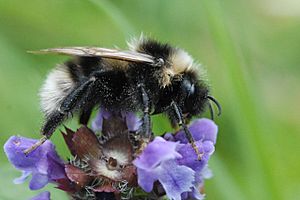Short-haired bumblebee facts for kids
Quick facts for kids Short-haired bumblebee |
|
|---|---|
 |
|
| Scientific classification | |
| Genus: |
Bombus
|
| Species: |
subterraneus
|
The short-haired bumblebee (scientific name: Bombus subterraneus) is a type of bumblebee. You can find these bees in parts of Europe and Asia. They also live in New Zealand, but they were brought there by people, so they are an introduced species. This means they are not naturally from New Zealand.
These bumblebees used to live in the British Isles (like the UK) and other parts of Europe. Sadly, they disappeared from the British Isles in 1989. Scientists are not completely sure why they vanished so quickly. Many think it was because they did not have enough genetic diversity. This means their genes were too similar, which can make a group of animals less healthy and less able to survive changes.
Contents
Bringing Back the Short-Haired Bumblebee
The short-haired bumblebee was one of four types of bumblebees brought to New Zealand from the United Kingdom between 1885 and 1906. They were brought there to help pollinate (carry pollen between flowers) a plant called red clover.
In New Zealand, the short-haired bumblebee is the rarest of the four types that were introduced. Only a few of them live in certain places in the middle of the South Island. The last time anyone saw a short-haired bumblebee in the United Kingdom was in 1988. People thought they were completely gone from there.
First Try to Reintroduce Them
In 2009, a plan started to bring these bumblebees back to the United Kingdom. They tried to do this by bringing queen bees from New Zealand. Several groups worked together on this plan. These included Natural England, the Bumblebee Conservation Trust, the Royal Society for the Protection of Birds, and a bee and wasp charity called Hymettus.
However, this first try was not successful. Many of the queen bees died during hibernation. Hibernation is like a deep sleep that some animals go into during winter. Scientists also checked the DNA of the New Zealand bees. They found that these bees did not have much genetic diversity, which made them less strong.
Second Try to Reintroduce Them
In 2012, they tried again to bring the short-haired bumblebee back. This time, they used queen bees from a place called Skåne in southern Sweden. By the summer of 2013, they found worker bees from this species living within 5 kilometres of where the queens were released. This was good news because it showed that the bees had successfully built nests and were having babies.
The project kept collecting queen bumblebees from Skåne until the spring of 2016. They did this to make sure the new group of bees had a good mix of genes. This helps the bees be healthier and stronger in the long run.
Images for kids
See also
 In Spanish: Abejorro de pelo corto para niños
In Spanish: Abejorro de pelo corto para niños


